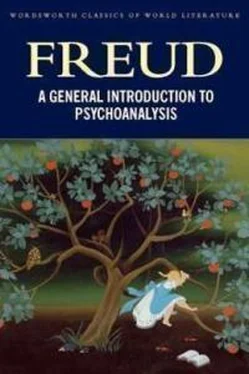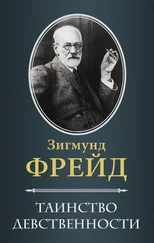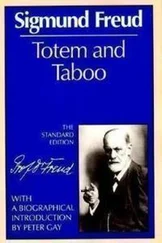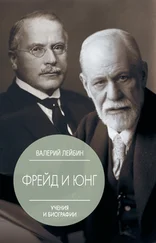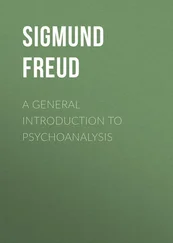We can go no further here, for you have probably long been disturbed by a reflection which deserves to be heard. Are the day–remnants, you ask, really unconscious in the same sense as the unconscious wish which is essential to making them suitable for the dream? You discern correctly. Here lies the salient point of the whole affair. They are not unconscious in the same sense. The dream wish belongs to a different unconsciousness, that which we have recognized as of infantile origin, fitted out with special mechanisms. It is entirely appropriate to separate these two types of unconsciousness and give them different designations. But let us rather wait until we have become acquainted with the field of neurotic symptoms. If people say one unconsciousness is fantastic, what will they say when we acknowledge that we arrived at our conclusions by using two kinds of unconsciousness?
Let us stop here. Once more you have heard something incomplete; but is there not hope in the thought that this science has a continuation which will be brought to light either by ourselves or by those to follow? And have not we ourselves discovered a sufficient number of new and surprising things?
[36]I do not mention another obvious interpretation of this "3" in the case of this childless woman, because it is not material to this analysis.
Fifteenth Lecture
The Dream - Doubtful Points and Criticism
Let us not leave the subject of dreams before we have touched upon the most common doubts and uncertainties which have arisen in connection with the new ideas and conceptions we have discussed up to this point. The more attentive members of the audience probably have already accumulated some material bearing upon this.
1. You may have received the impression that the results of our work of interpretation of the dream have left so much that is uncertain, despite our close adherence to technique, that a true translation of the manifest dream into the latent dream thoughts is thereby rendered impossible. In support of this you will point out that in the first place, one never knows whether a specific element of the dream is to be taken literally or symbolically, since those elements which are used symbolically do not, because of that fact, cease to be themselves. But if one has no objective standard by which to decide this, the interpretation is, as to this point, left to the discretion of the dream interpreter. Moreover, because of the way in which the dream work combines opposites, it is always uncertain whether a specific dream element is to be taken in the positive or the negative sense, whether it is to be understood as itself or as its opposite. Hence this is another opportunity for the exercise of the interpreter's discretion. In the third place, in consequence of the frequency with which every sort of inversion is practised in the dream, the dream interpreter is at liberty to assume such an inversion at any point of the dream he pleases. And finally you will say, you have heard that one is seldom sure that the interpretation which is found is the only possible one. There is danger of overlooking a thoroughly admissible second interpretation of the same dream. Under these circumstances, you will conclude there is a scope left for the discretion of the interpreter, the breadth of which seems incompatible with the objective accuracy of the results. Or you may also conclude that the fault does not rest with the dream but that the inadequacies of our dream interpretation result from errors in our conceptions and hypotheses.
All your material is irreproachable, but I do not believe that it justifies your conclusions in two directions, namely, that dream interpretation as we practice it is sacrificed to arbitrariness and that the deficiency of our results makes the justification of our method doubtful. If you will substitute for the arbitrariness of the interpreter, his skill, his experience, his comprehension, I agree with you. We shall surely not be able to dispense with some such personal factor, particularly not in difficult tasks of dream interpretation. But this same state of affairs exists also in other scientific occupations. There is no way in which to make sure that one man will not wield a technique less well, or utilize it more fully, than another. What might, for example, impress you as arbitrariness in the interpretation of symbols, is compensated for by the fact that as a rule the connection of the dream thoughts among themselves, the connection of the dream with the life of the dreamer, and the whole psychic situation in which the dream occurs, chooses just one of the possible interpretations advanced and rejects the others as useless for its purposes. The conclusion drawn from the inadequacies of dream interpretation, that our hypotheses are wrong, is weakened by an observation which shows that the ambiguity and indefiniteness of the dream is rather characteristic and necessarily to be expected.
Recollect that we said that the dream work translates the dream thoughts into primitive expressions analogous to picture writing. All these primitive systems of expression are, however, subject to such indefiniteness and ambiguities, but it does not follow that we are justified in doubting their usefulness. You know that the fusion of opposites by the dream–work is analogous to the so–called "antithetical meaning of primitive words," in the oldest languages. The philologist, R. Abel (1884), whom we have to thank for this point of view, admonishes us not to believe that the meaning of the communication which one person made to another when using such ambiguous words was necessarily unclear. Tone and gesture used in connection with the words would have left no room for doubt as to which of the two opposites the speaker intended to communicate. In writing, where gesture is lacking, it was replaced by a supplementary picture sign not intended to be spoken, as for example by the picture of a little man squatting lazily or standing erect, according to whether the ambiguous hieroglyphic was to mean "weak" or "strong." It was in this way that one avoided any misunderstanding despite the ambiguity of the sounds and signs.
We recognize in the ancient systems of expression, e.g., the writings of those oldest languages, a number of uncertainties which we would not tolerate in our present–day writings. Thus in many Semitic writings only the consonants of words are indicated. The reader had to supply the omitted vowels according to his knowledge and the context. Hieroglyphic writing does not proceed in exactly this way, but quite similarly, and that is why the pronunciation of old Egyptian has remained unknown to us. The holy writings of the Egyptians contain still other uncertainties. For example, it is left to the discretion of the writer whether or not he shall arrange the pictures from right to left or from left to right. To be able to read we have to follow the rule that we must depend upon the faces of the figures, birds, and the like. The writer, however, could also arrange the picture signs in vertical rows, and in inscriptions on small objects he was guided by considerations of beauty and proportion further to change the order of the signs. Probably the most confusing feature of hieroglyphic writing is to be found in the fact that there is no space between words. The pictures stretch over the page at uniform distances from one another, and generally one does not know whether a sign belongs to what has gone before or is the beginning of a new word. Persian cuneiform writing, on the other hand, makes use of an oblique wedge sign to separate the words.
The Chinese tongue and script is exceedingly old, but still used by four hundred million people. Please do not think I understand anything about it. I have only informed myself concerning it because I hoped to find analogies to the indefinite aspects of the dream. Nor was I disappointed. The Chinese language is filled with so many vagaries that it strikes terror into our hearts. It consists, as is well known, of a number of syllable sounds which are spoken singly or are combined in twos. One of the chief dialects has about four hundred such sounds. Now since the vocabulary of this dialect is estimated at about four thousand words, it follows that every sound has on an average of ten different meanings, some less but others, consequently, more. Hence there are a great number of ways of avoiding a multiplicity of meaning, since one cannot guess from the context alone which of the ten meanings of the syllable sound the speaker intended to convey to the hearer. Among them are the combining of two sounds into a compounded word and the use of four different "tones" with which to utter these syllables. For our purposes of comparison, it is still more interesting to note that this language has practically no grammar. It is impossible to say of a one–syllable word whether it is a noun, a verb, or an adjective, and we find none of those changes in the forms of the words by means of which we might recognize sex, number, ending, tense or mood. The language, therefore, might be said to consist of raw material, much in the same manner as our thought language is broken up by the dream work into its raw materials when the expressions of relationship are left out. In the Chinese, in all cases of vagueness the decision is left to the understanding of the hearer, who is guided by the context. I have secured an example of a Chinese saying which, literally translated, reads: "Little to be seen, much to wonder at." That is not difficult to understand. It may mean, "The less a man has seen, the more he finds to wonder at," or, "There is much to admire for the man who has seen little." Naturally, there is no need to choose between these two translations, which differ only in grammar. Despite these uncertainties, we are assured, the Chinese language is an extraordinarily excellent medium for the expression of thought. Vagueness does not, therefore, necessarily lead to ambiguity.
Читать дальше
